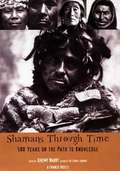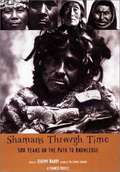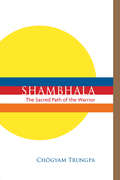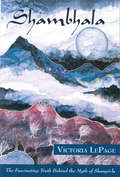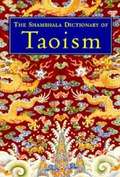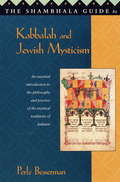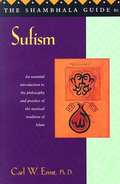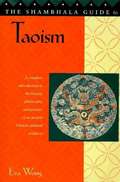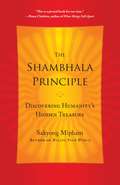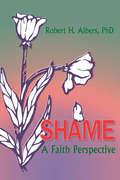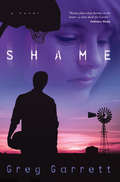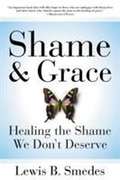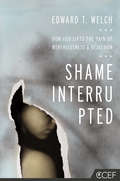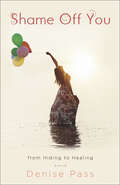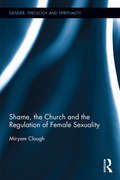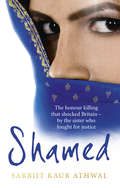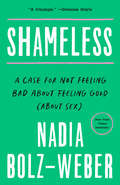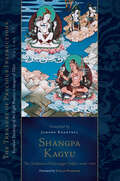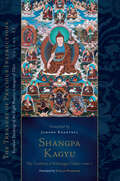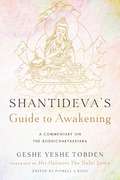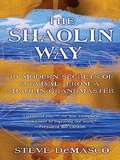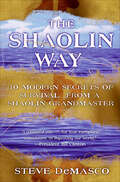- Table View
- List View
Shamans Through Time
by Jeremy NarbyA survey of five centuries of writings on the world's great shamans-the tricksters, sorcerers, conjurers, and healers who have fascinated observers for centuries. This collection of essays traces Western civilization's struggle to interpret and understand the ancient knowledge of cultures that revere magic men and women-individuals with the power to summon spirits. As written by priests, explorers, adventurers, natural historians, and anthropologists, the pieces express the wonder of strangers in new worlds. Who were these extraordinary magic-makers who imitated the sounds of animals in the night, or drank tobacco juice through funnels, or wore collars filled with stinging ants? Shamans Through Time is a rare chronicle of changing attitudes toward that which is strange and unfamiliar. With essays by such acclaimed thinkers as Claude Lévi-Strauss, Black Elk, Carlos Castaneda, and Frank Boas, it provides an awesome glimpse into the incredible shamanic practices of cultures around the world. .
Shamans Through Time: 500 Years on the Path to Knowledge
by Jeremy Narby Francis HuxleyThis collection of essays traces Western civilization's struggle to interpret and understand the ancient knowledge of cultures that revere magic men and women-individuals with the power to summon spirits. These writings by priests, explorers, adventurers, natural historians, and anthropologists express the wonder of strangers in new worlds. Who were these extraordinary people, men who imitated the sounds of animals in the night, or drank tobacco juice through funnels, or wore collars filled with stinging ants?Shamans Through Time is a rare chronicle of changing attitudes toward that which is strange and unfamiliar. With essays by such acclaimed thinkers as Claude LÉvi-Strauss, Black Elk, Carlos Castaneda, and Franz Boas, it provides an awesome glimpse into the incredible shamanic practices of cultures around the world.
Shambhala: The Sacred Path of the Warrior (Shambhala Classics)
by Carolyn Rose Gimian Chogyam TrungpaThere is a basic human wisdom that can help solve the world's problems. It doesn't belong to any one culture or region or religious tradition--though it can be found in many of them throughout history. It's what Chögyam Trungpa called the sacred path of the warrior. The sacred warrior conquers the world not through violence or aggression, but through gentleness, courage, and self-knowledge. The warrior discovers the basic goodness of human life and radiates that goodness out into the world for the peace and sanity of others. That's what the Shambhala teachings are all about, and this is the book that has been presenting them to a wide and appreciative audience for more than twenty years.
Shambhala
by Victoria LepageFor thousands of years, stories have been told about an inaccessible garden paradise hidden among the icy peaks and secluded valleys of the Himalayas. Called by some Shangri-la, this mythical kingdom, where the pure at heart live forever among jewel lakes, wish-fulfilling trees, and speaking stones, has fired the imagination of both actual explorers and mystical travelers to the inner realms. In this fascinating look behind the myth, Victoria LePage traces the links between this legendary Utopia and the mythologies of the world. Shambhala, LePage argues persuasively, is "real" and may be becoming more so as human beings as a species learn increasingly to perceive dimensions of reality that have been concealed for millennia.
Shambhala
by Victoria LepageFor thousands of years, stories have been told about an inaccessible garden paradise hidden among the icy peaks and secluded valleys of the Himalayas. Called by some Shangri-la, this mythical kingdom, where the pure at heart live forever among jewel lakes, wish-fulfilling trees, and speaking stones, has fired the imagination of both actual explorers and mystical travelers to the inner realms.In this fascinating look behind the myth, Victoria LePage traces the links between this legendary Utopia and the mythologies of the world. Shambhala, LePage argues persuasively, is "real" and may be becoming more so as human beings as a species learn increasingly to perceive dimensions of reality that have been concealed for millennia.
The Shambhala Dictionary of Taoism
by Ingrid Fischer-Schreiber Werner WunscheThis dictionary presents the basic terminology and doctrinal systems of Taoism in a clearly understandable form. The entries do not cover the entire range of Taoist concepts, for they are not intended for the use of academic specialists, but rather to help general readers find their way through the thicket of unfamiliar terms and concepts that are frequently encountered today in widely varied fields of interest--in the sciences, in the media, in the health professions, in psychotherapy, in the study of meditation, and in psychophysical training.
The Shambhala Guide to Kabbalah and Jewish Mysticism
by Perle BessermanJewish mystics from biblical times to the present have explored the hidden secrets of the Torah in quest of a single goal: to lose the self in the Infinite "No-thingness" (Ein Sof) and be at one with God. In language accessible to the layperson, this Shambhala Guide provides a detailed introduction to the complex world of Kabbalah and Jewish mysticism. With an extensive background in meditation practice, Perle Besserman emphasizes Kabbalah's spiritual disciplines, grounded in righteous living, devotional practices, and meditation. She discusses the Kabbalistic universe, including the four worlds and ten sefirot; Jewish meditation techniques and instructions for beginning meditation; mystics and teachers from Rabbi Akiva and the Baal Shem Tov to Aryeh Kaplan; the often uneasy relationship between Kabbalah and mainstream Judaism; and applying the ancient wisdom of Jewish mysticism to life in the world of today.
The Shambhala Guide to Sufism
by Carl W. ErnstThe soaring voice of Nusrat Fateh Ali Khan, the ecstatic dance of the Whirling Dervishes, the rapturous verse of Jalaluddin Rumi-all are expressions of Sufism, often regarded as the mystical tradition of Islam. Who are the Sufis? They are more than mystics; they are empowered by the Qur'an and the Prophet Muhammad. They are guided by saints and masters. They belong to orders ranging from North Africa and Turkey to India and Central Asia. In addition to prayer and fasting, they practice techniques of meditation. They recite poetry, delight in music, and perform dance, all towards one goal-union with God, the Divine Beloved. This comprehensive introduction clarifies the concept of Sufism and discusses its origin and development. In addition, the author discusses the important issues of Sufism's relationship with the larger Islamic world and its encounters with fundamentalism and modern secularism, along with the appropriation of Sufism by non-Muslims and the development of Sufi traditions in the West. From: http://www.amazon.com/Shambhala-Guide-Sufism-Carl-Ernst/dp/1570621802
The Shambhala Guide to Taoism
by Eva WongThis guide to the spiritual landscape of Taoism not only introduces the important events in the history of Taoism, the sages who wrote the Taoist texts, and the various schools of Taoist thinking, but also gives the reader a feel for what it means to practice Taoism today. The book is divided into three parts: "The History of Taoism" traces the development of the tradition from the shamans of prehistoric China through the classical period (including the teachings of the famous sage Lao-tzu), the beginnings of Taoism as a religion, the rise of mystical and alchemical Taoism, and the synthesis of Taoism, Buddhism, and Confucianism. "Systems of Taoism" explores magical sects, divination practices, devotional ceremonies, internal alchemy, and the way of right action. "Taoist Practices" discusses meditation, techniques of cultivating the body, and rites of purification, ceremony, and talismanic magic. A comprehensive bibliography for further study completes this valuable reference work.
The Shambhala Principle: Discovering Humanity's Hidden Treasure
by Sakyong MiphamOne of Tibet's highest and most respected lamas elucidates for us the principles of Shambhala, or the path to happiness, set down by his legendary father, Chögyam Trungpa Rinpoche.Dear Reader, We humans have come to a crossroads in our history: we can either destroy the world or create a good future. The Shambhala Principle offers the principle of basic goodness as a way of addressing the personal and social challenges that we face. Do we, as humans, have confidence in the basic goodness of humanity, as well as of society itself? As a Tibetan lama and spiritual leader, this strikes me as our most compelling global issue. The book revolves around a dialogue with my father, the legendary Chögyam Trungpa. Whether his responses were direct or mystical, he continuously returned to the topics of basic goodness and enlightened society. Not only did he show me how I could become confident in their existence through awareness and meditation, he also taught me how basic goodness is a socially viable standard that could stabilize and transform our world.However, this book is not a memoir, or even a message. It is an invitation to readers to reflect on their own basic goodness and the basic goodness of society, and then contemplate the question, Can we rouse our energy and confidence to create a good world that is founded on this principle? I encourage you to join me in this contemplation. --Sakyong Mipham
Shame: A Faith Perspective
by William M Clements Robert H AlbersIn this new guidebook, designated as one of the Top Ten Books of the Year for 1996 by The Journal of the Academy of Parish Clergy, author Robert H. Albers provides both an analysis of and a Biblical and theological reflection upon the human experience of disgrace shame. Albers approaches the subject from a pastoral perspective from which he makes suggestions on how this phenomenon can be dealt with from the background of a faith tradition. He develops and explores new and existing valuable conceptual and pastoral resources to aid people in dealing effectively with the debilitating experiences of disgrace shame.Shame: A Faith Perspective is unique in that it incorporates deliberate theological reflection upon the human experience of disgrace shame. Its value is in ”naming” this phenomenon, analyzing it, and identifying the resources for dealing effectively with this experience. It assists clergy and counselors in identifying this phenomenon and provides conceptual and practical suggestions on how to deal most effectively with disgrace shame. Clergy as well as laypeople can find answers to their questions about the nature of shame and become better equipped to facilitate the process of healing.Utilizing the findings of social sciences, the author provides specific information on shame including: Distinctions between shame and guilt Distinctions between ”discretionary” shame and ”disgrace” shame Identification of the dynamics of disgrace shame Analysis of the defenses used in dealing with disgrace shame Identification of the resources available from the Judeo-Christian tradition in reflecting theologically on the issue of disgrace shame Suggestions for ways in which disgrace shame might be dismantled from the perspective of faithFor parish pastors and priests, counselors and therapists, seminary professors teaching pastoral care, and nonordained people within the Christian community, Shame: A Faith Perspective provides a theologically informed method for addressing issues of disgrace shame. Readers can begin to distinguish between guilt and shame in human experience, search out theological resources for understanding, and learn to deal effectively with the experience of disgrace shame.
Shame
by Greg GarrettJohn Tilden's glory days are far behind him, and now it seems like all he has is the monotony of every day living. He certainly thought there'd be more to it than his ramshackle Oklahoma farm and a mundane job coaching basketball at his old high school. He questions his fatherhood skills too: his oldest son won't speak to him, his younger son wants to quit the basketball team, and now his daughter wants to go out on dates. He loves his wife, but the marriage has settled into complacency. Now his twentieth high school reunion looms and he has agreed to play in an exhibition game at the reunion, which is sure to be a wretched joke. And his ex-girlfriend's back in town, newly single. Twenty years is plenty long enough for a man to mope after what might have been. It's time for John to make himself understand that.
Shame and Grace: Healing the Shame We Don't Deserve
by Lewis B. SmedesA Proven Path to Move from Shame to Healing. If you persistently feel you don't measure up, you are feeling shame--that vague, undefined heaviness that presses on our spirit, dampens our gratitude for the goodness of life, and diminishes our joy. The good news is that shame can be healed. With warmth and wit, Lewis B. Smedes examines why and how we feel shame, and presents a profound, spiritual plan for healing. Step by step, Smedes outlines the road to well-being and the peace that comes from knowing we are accepted by the grace of One whose acceptance of us matters most.
Shame Interrupted: How God Lifts the Pain of Worthlessness and Rejection
by Edward T. WelchNo More HidingShame controls far too many of us. Worthless, inferior, rejected, weak, humiliated, failure...it all adds up to wishing we could get away from others and hide. We know what shame feels like. The way out, however, is harder to find. Time doesn't help, neither does confession, because shame is just as often from what others do to you as it is from what you have done. But the Bible is about shame from start to finish, and, if we are willing, God's beautiful words break through.Look at Jesus through the lens of shame and see how the marginalized and worthless are his favorites and become his people. God cares for the shamed. Through Jesus you are covered, adopted, cleansed, and healed.
Shame Lifter: Replacing Your Fears and Tears with Forgiveness, Truth, and Hope
by Marilyn HontzDo you ever berate yourself over minor happenings? Do you feel unworthy and wonder why God would love you? Do you struggle to overcome memories of verbal, emotional, or physical abuse? If so, you may be suffering from unhealthy shame which, if not corrected, can produce bitterness and negativity in your life. From the author of the acclaimed book Listening for God comes the life-transforming book Shame Lifter, based on author Marilyn Hontz's personal story of releasing her own shame and embarking instead on a life of freedom, forgiveness, and truth.
Shame Off You: From Hiding to Healing
by Denise Pass“There is therefore now no condemnation for those who are in Christ Jesus.” — Romans 8:1 Shame is an assault on the core of who we are. It assassinates our character, minimizes our worth, and dashes our hope. Like Adam and Eve, we often hide shame, but hiding never heals it. Left unattended, shame can develop into a crippling reality that paralyzes us. Like an infectious disease, shame impacts everyone . . . but not all shame is bad. Shame can either be an oppressive and powerful tool of worldly condemnation or a source of conviction that God uses to bring his people back to himself. Having the discernment to know the difference and recognize shame in its many forms can change the course of one’s life. In a transparently honest style, Pass shares of her experience dealing with shame after learning that her former husband was a sexual offender. Having lived through the aftermath, she leads you into God’s Word where you will see for yourself that God is bigger than your pain, shame, mistakes, and limitations. Shame Off You shares how freedom can be found in choosing to break the cycle of shame by learning from the past, developing healthy thinking patterns, silencing lies, and overcoming the traps of vanity and other people's opinions.
Shame, the Church and the Regulation of Female Sexuality (Gender, Theology and Spirituality)
by Miryam CloughShame strikes at the heart of human individuals rupturing relationships, extinguishing joy and, at times, provoking conflict and violence. This book explores the idea that shame has historically been, and continues to be, used by an oftentimes patriarchal Christian Church as a mechanism to control and regulate female sexuality and to displace men’s ambivalence about sex. Using a study of Ireland’s Magdalen laundries as a historical example, contemporary feminist theological and theoretical scholarship are utilised to examine why the Church as an institution has routinely colluded with the shaming of individuals, and moreover why women are consistently and overtly shamed on account of, and indeed take the blame for, sex. In addition, the text asks whether the avoidance of shame is in fact functional in men’s efforts to adhere to patriarchal gender norms and religious ideals, and whether women end up paying the price for the maintenance of this system. This book is a fresh take on the issue of shame and gender in the context of religious belief and practice. As such it will be of significant interest to academics in the fields of Religious Studies, but also History, Psychology and Gender Studies.
Shamed: The Honour Killing That Shocked Britain – by the Sister Who Fought for Justice
by Sarbjit Kaur AthwalIn 1998, Sarbjit Athwal was called by her husband to attend a family meeting. It looked like just another family gathering. An attractive house in west London, a large dining room, two brothers, their mother, one wife. But the subject they were discussing was anything but ordinary. At the head of the group sat the elderly mother. She stared proudly around, smiling at her children, then raised her hand for silence. ‘It’s decided then,’ the old lady announced. ‘We have to get rid of her.’‘Her’ was Surjit Athwal, Sarbjit’s sister-in-law. Within three weeks of that meeting, Surjit was dead: lured from London to India, drugged, strangled, and her body dumped in the Ravi River, never to be seen again.After the killing, risking her own life, Sarbjit fought secretly for justice for nine long, scared years. Eventually, with immense bravery, she became the first person within a murderer’s family ever to go into open court in an honour killing trial as the Prosecution’s key witness, and the first to waive her anonymity in such a trial. As a result of her testimony, the trial led to the first successful prosecution of an honour killing without the body ever being found.But her story doesn’t end there. Since the trial, her life has been threatened; her own husband arrested after an allegation of intimidation. Shamed is a story of fear and of horror – but also of immense courage, and a woman who risked everything to see that justice was done.
Shameless: A Sexual Reformation
by Nadia Bolz-WeberRaw, intimate, and timely, Nadia Bolz-Weber’s latest book offers a full-blown overhaul of our harmful and antiquated ideas about sex, gender, and our bodies. Christians are obsessed with sex. But not in a good way. For generations countless people have suffered pain, guilt, and judgment as a result of this toxic fixation on sex, the body, and physical pleasure. <P><P>In the follow-up to her celebrated New York Times bestseller Accidental Saints, Bolz-Weber unleashes her critical eye, her sharp pen, and her vulnerable but hopeful soul on the caustic, fear-riddled, and religiously inspired messages about sex that have fed our shame. <P><P>In turn, Bolz-Weber offers no simple amendments or polite compromises, because the stakes are too high—and our souls and our bodies are worth too much. Instead, this tattooed, swearing, modern-day pastor calls for a new reformation. She urges us to take antiquated, sexist ideas about sex, gender, and our bodies and “burn them the f*ck down and start all over.” <P><P>This is a journey of holy resistance. Along the way, as antidotes to shame, heresy, and all-too-familiar injustice, Bolz-Weber dispenses grace, freedom, and courage. She shares stories, poetry, and scripture, cultivating resilient hope and audacious love rooted in good news that is “powerful enough, transgressive enough, and beautiful enough to heal not only the ones who have been hurt but also those who have done the hurting.” <P><P>In Bolz-Weber’s most personal, bracingly honest book yet, she shares intimately about her life, with her trademark blend of vulnerability, humor, and candor. If you’ve been mistreated, confused, angered, and/or wounded by the shaming sexual messages so prevalent in religion, this one is for you. <P><P><b> A New York Times Bestseller</b>
Shangpa Kagyu: Essential Teachings of the Eight Practice Lineages of Tibet, Volume 12 (The Treasury of Precious Instructions)
by Jamgon Kongtrul Lodro TayeIn this twelfth volume of The Treasury of Precious Instructions, Jamgön Kongtrul Lodrö Taye presents a second collection of compiled teachings and practices of the Shangpa Kagyu tradition of Tibetan Buddhism, focusing on the teachings of the lineages of two Indian female celestial beings, Niguma and Sukkhasiddhi.The Treasury of Precious Instructions by Jamgön Kongtrul Lodrö Taye, one of Tibet's greatest Buddhist masters, presents essential teachings from a broad spectrum of practice lineages that existed in Tibet. Volumes in this series may be engaged as practice manuals while also preserving ancient teachings significant to the literature and history of world religions. Volume 12 of the series is the second of two volumes that present teachings and practices from the Shangpa Kagyu practice lineage of Tibetan Buddhism. This tradition derives from the female celestial beings, or ḍākinīs, Niguma and Sukhasiddhi and their disciple, the eleventh-century Tibetan yogi Khyungpo Naljor Tsultrim Gönpo of the Shang region of Tibet. There are forty texts in this volume, beginning with Jonang Tāranātha&’s classic commentary and its supplement expounding the Six Dharmas of Niguma. It includes the definitive collection of the tantric basis of the Shangpa Kagyu—the five principal deities of the new translation (sarma) traditions and the Five-Deity Cakrasamvara practice. The source scriptures, liturgies, supplications, empowerment texts, instructions, and practice manuals were composed by Tangtong Gyalpo, Tāranātha, Jamgön Kongtrul, and others.
Shangpa Kagyu: Essential Teachings of the Eight Practice Lineages of Tibet, Volume 11 (The Treasury of Precious Instructions) (The Treasury of Precious Instructions)
by Jamgön Kongtrul ThayéA compilation of teachings and practices of the Shangpa Kagyu lineage of Tibetan Buddhism by one of Tibet's greatest Buddhist masters.The Treasury of Precious Instructions by Jamgön Kongtrul Lodrö Taye, one of Tibet's greatest Buddhist masters, is a shining jewel of Tibetan literature, presenting essential teachings from the entire spectrum of practice lineages that existed in Tibet. Volumes in this series may be engaged as practice manuals while also preserving ancient teachings significant to the literature and history of world religions. Volume 11 of the series, Shangpa Kagyu, is the first of two volumes that present teachings and practices from the Shangpa Kagyu practice lineage of Tibetan Buddhism. This tradition derives from the female celestial beings, or ḍākinīs, Niguma and Sukhasiddhi and their disciple, the eleventh-century Tibetan yogi Khyungpo Naljor Tsultrim Gönpo of the Shang region of Tibet. The scriptural source material for this practice tradition is twofold: the yogic teachings of the Six Dharmas of Niguma and the nature of mind instructions from the cycle of teachings Amulet Box Mahamudra. The tantric basis of the Shangpa Kagyu tradition is the five principal deities of the new translation (sarma) traditions and in particular the Five-Deity Cakrasamvara practice. The six parts of this sizable volume include source scriptures, liturgies, supplications, empowerment texts, instructions, and practice manuals composed by Niguma, Virūpa, Tāranātha, the compiler Jamgön Kongtrul, and others.
Shantideva's Guide to Awakening: A Commentary on the Bodhicharyavatara
by Fiorella Rizzi His Holiness the Dalai Lama Manu Bazzano Sarita Doveton Yeshe TobdenThe most comprehensive modern commentary on Shantideva’s master work.One of the great classics of Buddhist literature, the Bodhicharyavatara, or Way of the Bodhisattva, is required reading for understanding Tibetan Buddhism. Presented in the form of a personal meditation in verse, Shantideva, the seventh-century Buddhist master, outlines the path of the bodhisattvas—those who renounce the peace of their own liberation, vowing instead to attain enlightenment for the sake of all others. The Dalai Lama once remarked that his own understanding of the bodhisattva path is based entirely upon this text. Expounded by an accomplished scholar and deeply realized meditator, Shantideva's Guide to Awakening is a resource for a lifetime of study. Chapter by chapter and verse by verse, Geshe Yeshe Tobden maps the Bodhicharyavatara in clear and insightful language, helping us to deepen our understanding of its teachings and apply them to our lives.
The Shantung Revival
by Mary K. CrawfordFrom 1932-1933, a revival swept through the Chinese Christian church, particularly in the Shantung province. This book is a compilation of letters from various missionaries, personal accounts from those impacted by the revival, etc. Each chapter discusses a different aspect of God's power--confession of sins and salvation through Christ, the baptism and fullness of the Holy Spirit, gifts of healing, etc.
The Shaolin Way: 10 Modern Secrets of Survival from a Shaolin Kung Fu Grandmaster
by Steve DemascoDeMasco joins monks at the Shaolin Temple and learns their fighting techniques. In the process, he uncovers an ancient philosophy that helps him to learn, grow, and over come his past. In this book, he shares his philosophy and gives ten secrets for survival that will help others to live a more fulfilled life.
The Shaolin Way: Ancient Secrets of Survival, Healing and
by Steve DeMasco Alli JosephBorn in the projects of Spanish Harlem to a disabled mother and an abusive father, Steve DeMasco spent most of his childhood lost and angry. Drifting from one job to another, he stalked the streets as a troubled youth, barely surviving while all of his peers were either dead or in jail, until he found himself on the steps of the Shaolin Temple.Originating more than 1,500 years ago in ancient China, the Shaolin monks were simple farmers and worshippers of Buddhism who learned to protect themselves from the constant danger of bandits and overlords with a kind of "meditation in motion," a nonlethal form of self-defense that didn't violate their vows of peace. As their legend grew, they became known as the Shaolin Fighting Monks, revered across the land for their spiritual dedication, enlightened message, and amazing fighting skills.DeMasco entered the Shaolin Temple to battle the demons of his past. But he got more than he bargained for. Besides learning how to wield weapons and take on multiple attackers at once, he discovered an ancient philosophy that helped melt away preconceived notions of the world, and gave him a powerful platform on which to live and grow. In The Shaolin Way, he adapts these teachings for the modern world, singling out ten secrets of survival that can help anyone live a more fulfilled life.
